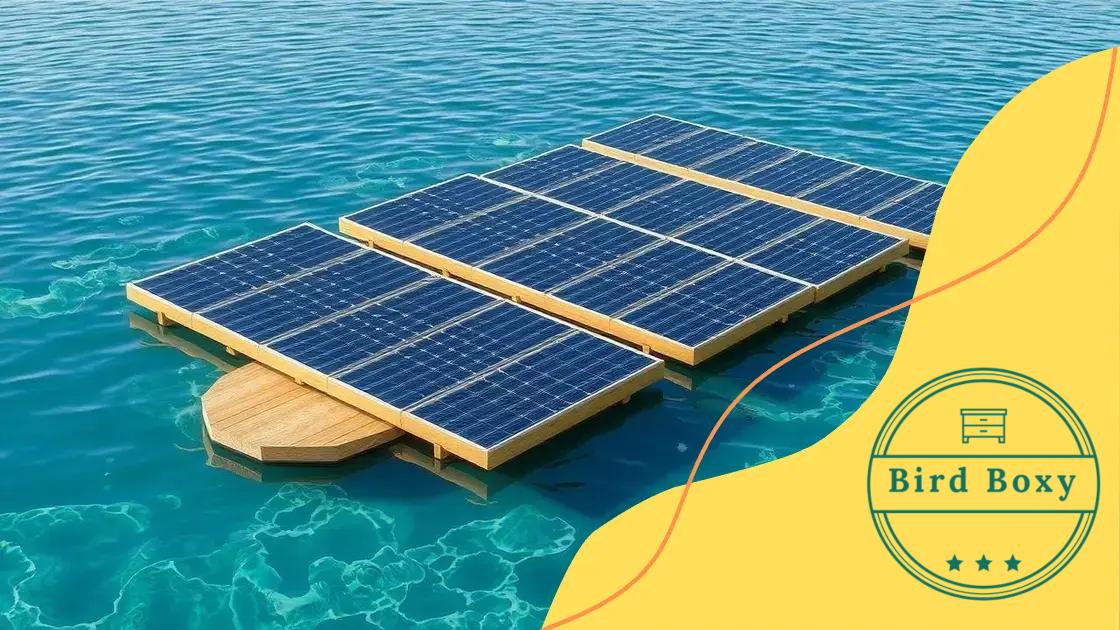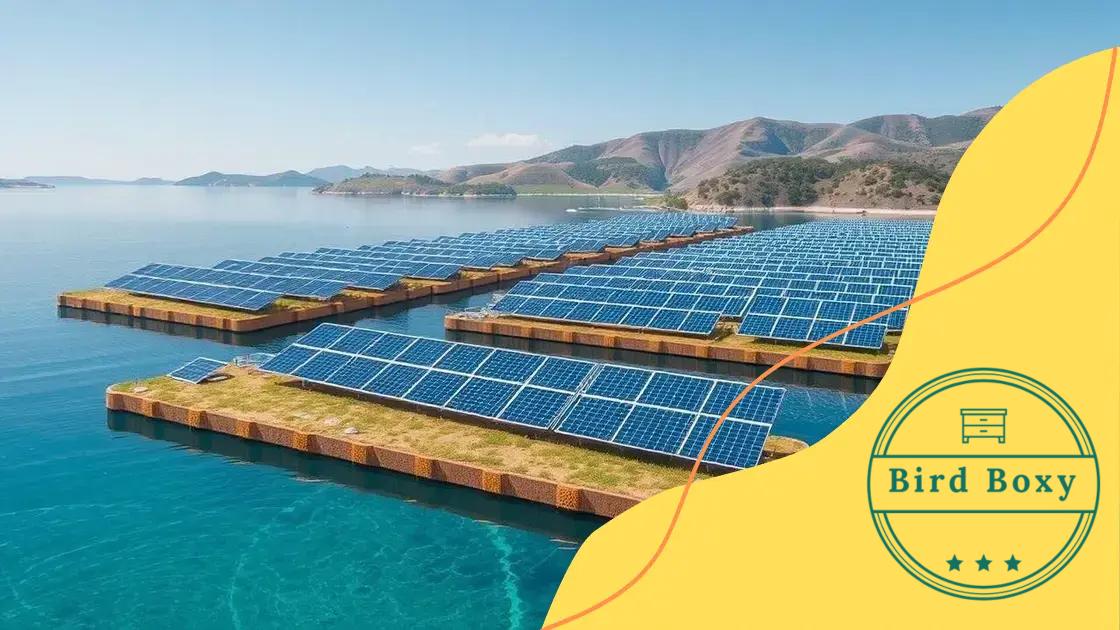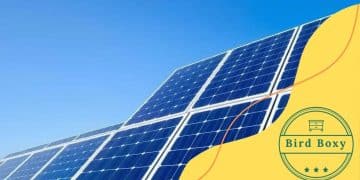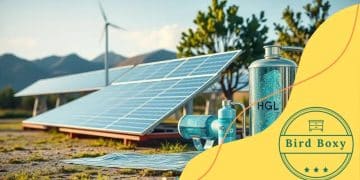Floating solar farms growth: the future of renewable energy

Floating solar farms are innovative energy solutions that utilize solar panels on water bodies to maximize efficiency, reduce land use, and decrease water evaporation, providing sustainable energy while benefiting the environment.
Floating solar farms growth is rapidly gaining attention as an innovative solution to harness renewable energy. Have you ever thought about how these farms can transform our approach to solar energy? In this article, we will dive into their advantages and real-world applications.
Understanding floating solar farms
Understanding floating solar farms is essential as we move toward cleaner energy solutions. These innovative systems allow solar panels to float on bodies of water, such as lakes and reservoirs. This method not only saves land space but also helps to reduce evaporation from water sources.
One of the main attractions of floating solar farms is their efficiency. When solar panels are placed on water, they can remain cooler than those on land. This cooler temperature allows them to operate more efficiently and produce more energy.
Key advantages of floating solar farms
There are several benefits to consider:
- Maximized space usage: Floating solar installations utilize existing bodies of water, maximizing land resources.
- Reduction of algae growth: The shade from the panels can help limit algae bloom, promoting healthier water quality.
- Lower infrastructure costs: Farmers and communities can save by using existing water resources rather than seeking additional land.
Moreover, floating solar farms can be combined with fish farming, as the structures support aquatic life. This synergy can create a unique ecosystem and increase local benefits from both industries. With the dual benefits of energy generation and aquatic health, more regions are exploring this exciting technology.
In conclusion, floating solar farms represent a promising solution for sustainable energy. By harnessing sunlight on water surfaces, we can tap into abundant energy while protecting valuable land resources. As technology advances, the global shift towards floating solar solutions may just be the remedy we need in the fight against climate change.
Benefits of floating solar energy
Exploring the benefits of floating solar energy reveals why this technology is becoming popular worldwide. Floating solar farms offer a unique set of advantages that traditional solar installations cannot match. For instance, they maximize energy production while conserving valuable land resources.
One major benefit is the cooling effect of water on solar panels, which can increase their efficiency. Cooler temperatures allow the panels to produce more energy, optimizing performance.
Environmental benefits of floating solar
Floating solar farms provide crucial environmental advantages:
- Reduction of land use: These systems do not displace agriculture or urban development.
- Improved water quality: They can reduce evaporation and limit algae growth, helping maintain healthier ecosystems.
- Less land competition: This allows for easier installation in densely populated areas.
Furthermore, floating solar energy can create new job opportunities. As these farms require maintenance, financial and technical roles will emerge, benefiting local economies. Community members can participate in new projects that contribute to sustainability.
Another critical aspect is that floating solar installations can be combined with other activities, such as aquaculture. This synergy not only produces renewable energy but also supports local fish farming, enhancing the economic viability of the area.
As society looks to combat climate change, floating solar energy stands out as a promising solution. By harnessing the sun’s energy in innovative ways, we can contribute to a sustainable future while benefiting both our economy and our environment.
Challenges in implementing floating solar farms

Implementing floating solar farms comes with various challenges that need careful consideration. While the technology offers numerous benefits, navigating regulatory, environmental, and technical hurdles is essential for successful deployment.
One significant challenge is obtaining the necessary permits and approvals from local authorities. Regulations may vary greatly depending on the location and can complicate installation. Ensuring compliance with environmental laws while meeting energy needs adds complexity to project planning.
Technical challenges of floating solar farms
Technical issues also play a crucial role in the feasibility of these projects:
- Durability of materials: The equipment used must withstand harsh weather conditions, such as wind and waves.
- Corrosion from water: Saltwater, in particular, can damage components, requiring more durable materials.
- Installation complexity: Deploying solar panels on water surfaces may require specialized vessels and equipment.
In addition to technical concerns, there are environmental implications to consider. Installing floating solar farms can affect aquatic ecosystems. Care must be taken to study and monitor how these systems interact with local wildlife.
Another challenge involves managing the energy produced. Integrating floating solar energy with existing grids can require additional infrastructure, such as storage solutions. Balancing energy supply and demand is vital to maximizing the efficacy of these installations.
Despite these challenges, advancements in technology provide hope for more efficient and effective solutions. As the demand for renewable energy grows, overcoming these obstacles will be crucial in the expansion of floating solar energy.
Innovative technologies for floating solar systems
Innovative technologies are transforming the landscape of floating solar systems. These advancements not only enhance efficiency but also make installations more viable in various environments. Harnessing new approaches is key to maximizing the benefits of floating solar farms.
One exciting development is the use of advanced materials for solar panels. Lightweight and more durable materials allow for easier installation and better performance on water surfaces. These innovations help reduce costs and improve the overall lifespan of floating solar systems.
Key technologies in floating solar
Some specific technologies improving floating solar systems include:
- Dynamic anchoring systems: These systems adjust to water movement, ensuring stability and security for solar panels.
- Monitoring and predictive analytics: Sensors and IoT devices track performance and optimize energy production in real-time.
- Integrated energy storage solutions: These keep energy generated during sunny days for use when sunlight is minimal, balancing supply and demand effectively.
Moreover, integrating floating solar with existing infrastructure can enhance energy efficiency. Utilizing river systems and lakes near urban areas allows cities to benefit from renewable energy without needing new land.
New designs also focus on dual-use applications. Floating solar systems can coexist with aquaculture or recreation facilities, creating multifunctional spaces. This not only increases energy production but also benefits local communities by providing additional resources.
As the demand for energy continues to grow, these innovative technologies will play an essential role in expanding the reach and effectiveness of floating solar energy solutions.
Case studies: successful floating solar projects
Examining successful floating solar projects provides valuable insights into the effectiveness of this technology. Several notable installations around the world showcase the potential of floating solar farms to generate renewable energy efficiently while utilizing water bodies.
One prominent example is the floating solar farm in China’s Huainan City. This project covers about 100 hectares of a former coal mine and has a capacity of 40 MW. By using the water surface, this installation minimizes land competition, making it an excellent model for similar projects.
Global examples of floating solar success
Several countries have successfully implemented floating solar projects:
- Japan: The Yamakura Dam floating solar plant generates 13.7 MW and has helped optimize water resources by reducing evaporation.
- India: The 600 MW project in Kallettumkara is set on a reservoir, demonstrating how floating solar can be integrated with storage capacities to address energy demands.
- France: The Lake of Saint-Pierre hosts a 17 MW floating solar installation that has reduced water evaporation while providing clean energy.
These projects highlight the versatility and adaptability of floating solar energy. They not only produce electricity but also provide solutions to water protection and land stress, making them exemplary models for future advancements.
Moreover, many of these successful case studies focus on community engagement and environmental benefits. By involving local stakeholders in the planning and execution phases, these projects strengthen social acceptance and make a case for similar developments worldwide.
FAQ – Frequently Asked Questions about Floating Solar Farms
What are floating solar farms?
Floating solar farms are solar panel installations that are mounted on bodies of water, allowing for efficient energy production without using valuable land resources.
What are the benefits of floating solar energy?
Floating solar energy helps to reduce water evaporation, maximizes space usage, and often leads to increased energy efficiency due to cooler temperatures for the panels.
What are some challenges in implementing floating solar projects?
Challenges include obtaining permits, ensuring durability against environmental conditions, and managing potential impacts on local ecosystems.
Can floating solar farms coexist with other activities?
Yes, floating solar farms can be integrated with aquaculture and other recreational activities, promoting multifunctional use of water bodies.






